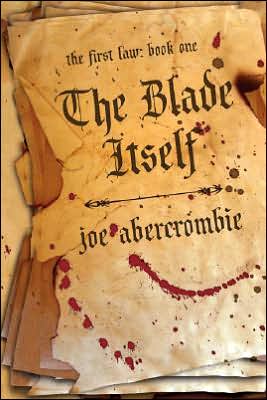It’s standard practice to end the first volume of a trilogy with a cliffhanger—but how about starting the series with one? That’s what Joe Abercrombie does in the prologue for The Blade Itself, as Northern warrior Logen Ninefingers dangles over the edge of a precipice, an equally vicious raider clutching at his ankles. I’m not giving anything away by saying he survives the fall… or that it quickly becomes the least of the crises he’ll have to face, none of them with any great enthusiasm.
If you like the panoramic sweep of George R.R. Martin’s worldbuilding, there’s a good chance you’ll dig The Blade Itself. Abercrombie grounds the majority of the story in three viewpoint characters. Soon after crawling out of the river at the bottom of the cliff, Logen learns that he’s been summoned by the great magus Bayaz, who wants Logen to accompany him on a mission to Adua, the capital city of the Union. By the time they arrive, we’re already quite familiar with two of that city’s residents: Jezal dan Luthar, a dandy-ish aristocratic military officer who is resentfully training for the Union’s annual swordfighting competition, and Sand dan Glokta, a former Contest champion himself (about a decade back) who barely survived a long captivity as a prisoner of war and now works as a torturer for the Inquisition. The three storylines meet in the middle, bounce off each other for a bit, and then settle into a synchronous orbit that leads to some spectacular set-pieces in the novel’s back half.
Abercrombie’s universe is as dark as Martin’s, maybe even a little darker. It’s not enough that Glokta’s captors crippled his leg, for example, or even that they yanked out several of his teeth—they made sure that the remaining teeth in the top and bottom rows never touched, making it impossible for him to chew. Small wonder, then, he’s become gleefully sadistic in his work, without ever letting his suspicions drop. “Why me?” he wonders when his superior charges him with building a case against some of the Union’s most prominent citizens. “Because of my results? Or because I won’t be missed?”
How pervasive is the meanness and brutality? Let’s put it this way: There’s an emperor who doesn’t even appear in the book, and one of the first things we learn about him is that he was his father’s youngest son but, upon hearing of the previous emperor’s death, had all his older brothers strangled. The Blade Itself could almost read as a grim, ultraviolent parody of A Song of Ice and Fire, with hyper-accelerated political intrigue covered in blood and guts and shot through with savagely dark humor, except that Abercrombie works hard to keep even the most venal or manipulative of his primary characters well-rounded. You may not quite sympathize with some of these people, but you’ll be able to understand where they’re coming from.
?There are a few awkward passages, where it seems like Abercrombie is still finding his way around the epic voice, but for the most part he has a firm grasp on constructing scenes for maximum dramatic effect. A passing joke about Logen trying to eat a flower from a decorative setting at a royal banquet segues effortlessly into a chilling discourse on military strategy; a fleeting encounter with Jezal and a female companion reveals not just the depth of Glokta’s hatred but the ease with which he can still be affected by human kindness. All the while, Abercrombie maneuvers his pieces into position, setting up the Union for wars with its neighbors to both the north and south, bringing secondary characters into the foreground for future prominence, doing everything he can to assure us the story can only get bigger. As The Blade Itself ends, the real purpose of Bayaz’s trip to Adua has only just been revealed, with Logen’s continued involvement unguaranteed, Jezal’s dreams of military glory have been abruptly shattered, and Glokta has received yet another devious assignment. After all, if you’re going to start a novel with a cliffhanger, what can you do but end it with several?
Ron Hogan is the founding curator of Beatrice.com, one of the first websites to focus on books and authors. Lately, he’s been reviewing science fiction and fantasy for Shelf Awareness.










